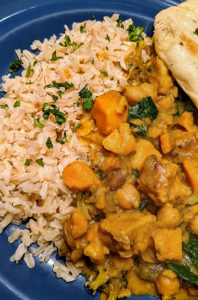Perfect Pilafs

By Chef Nancy Berkoff, RD, EdD
Pilafs originated in Persia, traveled through the Middle East and the Mediterranean and made it to the New World via the Caribbean. It is the preferred method of rice cooking in many parts of the world. Pilafs are most popular with long-grained rice, but they can be done with any rice, grain, or vegetable (such as mushrooms) that can stand up to heat and liquid.
This is the basic technique:
- Sauté the rice (or barley, quinoa, mushrooms, couscous, etc.) stirring constantly, in a small amount of vegetable oil or vegan margarine, until all grains are coated and mildly toasted
- Simmer, covered, in just enough liquid to allow the grain to become tender.
You can add fresh or dried herbs, minced garlic or vegetables, saffron threads, or a favorite seasoning mix. To serve about 5 people as a side dish, use 1 cup of rice (or grains) and about 2 cups of heated water (or vegetable stock). Spray some vegetable oil in a pot, add rice and sauté for about 2 minutes or until most of oil is absorbed and the grains are coated. Pour the heated liquid over the rice and allow it to simmer until it is soft, 15 to 20 minutes. Some people like to cook the rice on the stove until it is just soupy and then bake it, covered, until it is dry and fluffy.
Perfect Pilaf tips:
- It is better to make a pilaf in a wide pan than a tall pot. The surface area aids in better absorption of liquid.
- If using onion, dry it on a paper towel after its cut, so there’s not a lot of extra moisture added to the pilaf.
- To prevent sticking, stir as little as possible during the simmering phase.
- If you have to stir when the pilaf is simmering, use a fork. This incorporates more air and makes for fluffier pilaf.
- If adding vegetables to pilaf, cut them up as small as possible. This ensures consistent cooking.
- You can prepare pilaf up to two days ahead of time and just reheat as needed.
- If you like, you can make a “dry” pilaf, simply toasting the rice (or grain) in a hot pan, without the addition of oil. When the rice grains are toasted, add the liquid and proceed as described above.
